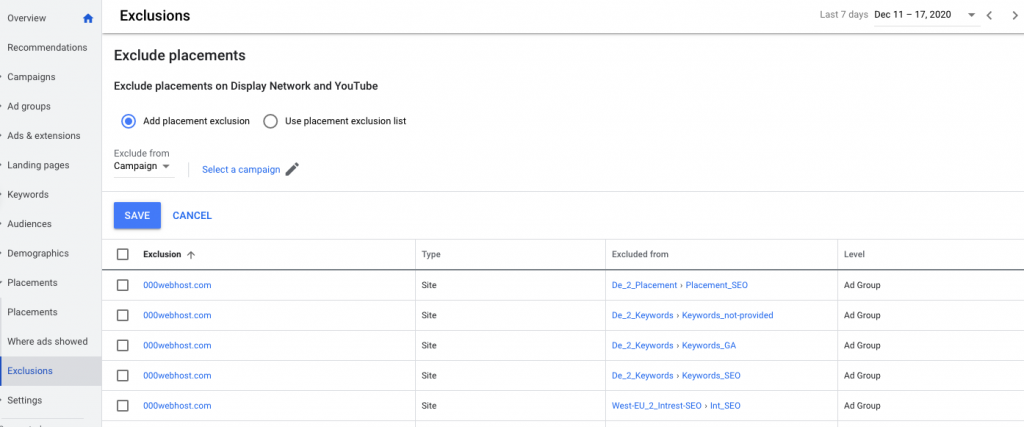PPC optimization strategies

You want to display your ads where they have the best conversion rates right?
That much is clear.
But to do that Google wants you to run an expensive ad campaign on the Google display advertising network.
You can save money by blacklisting websites that feel or look spammy before you start your campaign.
URLs with high click-through rates (CTR) can be blocked automatically.
There are numerous reasons why you might be getting a high number of clicks, but a low number of conversions.
Here are a few.
You are bidding on too general keywords

Keyword research for PPC campaigns is essential.
One of the first tools you should fire up is Google Keyword Planner.
Showing up on Google for the relevant search terms is key to reaching your final goal of driving conversions.
General keywords such as ‘Adidas’ tend to perform much less well than specific keywords, for example, ‘Adidas high top sneakers.’
Try to be as specific as possible.
At this stage, most businesses make one common mistake.
They are ready to spend a large amount on Google Ads, but they select high-volume keywords to bid on.
However, the higher the search volume keywords have, the less they convert.
Ad copy & landing page disconnect
Marketers are driven to attract their target audience with engaging ads. They offer discounts, freemiums, and giveaways, etc.
However, many visitors that come to a landing page because of a great discount will immediately retreat if it doesn’t apply.
It’s one of the most common reasons why your click-through rate is high while your conversion rate is low.
If you over-promise in your ad copy, but your landing page failed to fulfill users’ expectations, don’t expect high conversions.
Indeed, ad copy and landing pages that aren’t consistent may occur even if you didn’t intentionally try to deceive your prospects.
You could accidentally redirect visitors to the wrong page or simply overdo it with your marketing creative license.
You don’t consider your audience’s needs
Most of the users that come to your landing page have never heard of your company before.
If you’re trying to convert people that are at the top of a sales funnel with ‘Buy now’ it won’t work.
When a user comes across your brand for the first time, he needs a detailed description of the offer, some social proof, or even a chatbox to ask questions.
Every business has competitors, whether direct or indirect.
People know that if they don’t find a solution on your page, they can find it somewhere else.
Indeed, by not considering what a specific person might need at this stage of the sales process, you could be missing out on lots of conversions.
A child or non-target audience is clicking on your ads
This is why most exclusion lists (more on this later) will start with URLs like babygames.com because when a parent’s child just won’t stop crying, these days they will often be handed an iPad or a mobile phone to play baby games.
And babies are click machines. So while these sites might have incredible click-through rates for your ads, unless the baby is a member of Mensa, it’s unlikely that they will result in a conversion for your business.
Avoid websites vulnerable to click fraud
What does that mean? In brief, click fraud is the act of clicking on a pay per click Google ad placement with no intention of buying or using the product or service.
It is usually done with the objective of negatively impacting the advertisers budget or to give the false impression that a website is good to advertise on.
Why do I get fake clicks on my PPC ad campaigns?

Organized criminals who have created a way to get paid for clicking your ads. The World Federation of Advertisers predicts that ad fraud will become the biggest market for organized crime by 2025, estimated to be worth $50 billion.
Apps or software created to collect payouts from ads (often using bots).
When you consider that the price for some keywords in Google Ads can be upwards as much as $58, I’m looking at your ‘business services’, you can see why multiple fraudulent clicks can start to add up to a huge problem for businesses.
Sophisticated bots disguise themselves as legitimate visitors on a webpage and can click on an ad, a button, or any other type of hyperlink.
The goal of click fraud is to trick a platform or service into thinking real users are interacting with a web page, ad, or app.
Advertisers don’t know which sites they are buying space on, which makes it easy for a fraudster to pose as a genuine partner in this low visibility, digital ecosystem.
A common practice that exploits this is called domain spoofing. It involves criminals passing off low-quality inventory as a high-quality or premium site.
The same practice is employed with apps, called app name spoofing. Shockingly, fraud is estimated to amount to 20-35% of all ad impressions.
This is why trends like using a tested placement exclusion list is an important tool in this treacherous ecosystem.
5 tactics for paid search optimization
Google ‘PPC optimization’ and you’ll get 11.4 million results.
There is no end to paid search optimization tactics available online.
We’ve read most of them and now present the top five most effective tactics.
- Create a placement exclusion list

This should always be your first step. Although it is a painstaking process, you can’t avoid it.
Go to your Google Ad account, use the left navigation bar to find ‘Placements’ from there click ‘Exclusions’ and find the pen icon to add a new website.
You can either ‘add placement exclusion’ or ‘use placement exclusion list.’
Most ad agencies will have lists that they use, which block many poor-performing websites, but these tend to be lists that are updated irregularly and don’t take into consideration the post-click performance of these websites.
The lists are not based on a large dataset, so they might even exclude websites where you can easily have a high conversion rate, based on the most recent website performance.
2. Define your budget
The most popular pay per click (PPC) advertising platforms (Google Ads, Facebook Ads) require a daily budget. That can trick you into spending a lot of money before you realize it, with a poor return on advertising spend (ROAS).
But if you define an overall budget for your PPC campaigns, it’s easier to track your spending. And you won’t be in for a nasty surprise when the campaign is over.
You should also establish a maximum cost per conversion, i.e how much you are willing to spend to get a new customer?
If the amount of money you spent to get a new customer is lower than what you make from that customer, your campaign is running a loss.
You also need to estimate the customer lifetime value based on your average customer.
3. Use a dedicated landing page

If you want to take a chance and direct users that click your ads to your homepage, it’s worth a go.
But statistically, PPC advertising campaigns that use dedicated landing pages see a conversion rate improvement of at least 25%.
That’s because the human brain is wired to look for patterns.
Visitors should be able to locate easily on the landing page what they saw in your GDN placements.
If they don’t find it quickly or are confused in any way, they will bounce off your website. If you direct visitors to your homepage, you’re making them think: “What do I need to click here?
Where do I find what I saw in the ad?” Don’t leave them with an unnecessary treasure hunt, and set up a clear and consistent landing page.
4. Use a strong call to action
This is a fundamental, yet often overlooked golden rule of PPC advertising. If you don’t specifically tell your audience what to do next, they won’t do it.
Without a strong call to action, people won’t feel compelled to take the next step. According to perceptual set theory, the mind perceives objects through an active process of selection, inference and interpretation.
We naturally form expectations when we see a landing page or a Google display network ad and our brain predicts what should come next. The call to action bridges the gap between expectations and the intended next action.
To be effective, the call to action should fit in naturally with your copy. Pay attention to context and align your CTA with the rest of your copywriting.
For instance, don’t advertise a 10% discount for placement exclusion list software and use a call to action that says “submit”. Go for something that would go naturally with your landing page or PPC ad copy, for example, “Subscribe now” or “Buy now”.
5. Instal conversion tracking software
Most advertising networks provide conversion tracking, yet only a few marketers use it.
Bizarrely, just 48% of the Google AdWords accounts have conversion tracking enabled.
If you’ve set your PPC advertising objectives and an approximate maximum CPA, you know what you want to measure. It allows you to observe what users do on your website after they have clicked your ad.
It also enables you to see if you’re getting a return on investment from your campaigns. Without it, you don’t know if your campaigns are bringing in a profit or are running a loss.
This essential plugin allows you to see what users do on your website or landing page after they have clicked your ad. It also enables you to see if you’re getting a return on investment from your Google ad campaigns.
Without it, you will be left guessing if your campaigns are profitable or not.
Final thoughts
Veterans of AdWords optimization will know that the best strategy when it comes to Google placement exclusion lists is to start now.
It can be a painful, manual process of adding URLs and then monitoring their post-click performance then reviewing this list every month.
You can save a lot of time using AdShield’s ad fraud tool.
It works by:
- Analyzing billions of placements and click-behavior
- Combining placement data with data on user behavior on the landing page of the advertiser, focusing on conversions/events.
- Automatically pre-blocking low-quality websites and apps from your Google ad campaigns.
- Directly uploading to your Google Ads account.
The software reveals placement performance for a vast array of advertisers and URLs. AdShield also maintains vertical-specific exclusion lists.
These lists are updated daily, with new poor performing placements added to different exclusion lists.
Harnessing an AI-powered SaaS solution will instantly and verifiably save you time and money.